A famous string of galaxies in the constellation of Virgo, named after the astronomer Benjamin Markarian who first discovered their common motion. The chain contains several Messier catalogue objects and is visible in the late winter and spring in the Northern Hemisphere. The galaxies are located between 65-75 million light years away and are nice objects to observe with a telescope if you can do so from a dark sight.This image was created from a data set acquired in Spring 2019 with my FSQ85 refractor.Image is centred on “The Eyes” of NGC4435 and NGC4438 just below dead centre of the image. At the bottom is the monstrous supergiant elliptical galaxy M87, the most massive object in the local universe harbouring the famous black hole recently imaged with the event horizon telescope. Markarian’s Chain in Virgo Below is an inverted version that help show the galaxies with more contrast. Inverted Version…
The Perseus Galaxy Cluster (Abell 426) is one of the most massive known objects in The Universe. It is a supercluster of galaxies with thousands of individual members located between 230-280 million light years away. The galaxies are located within a vast cloud of enveloping gas, the gas being much more massive than the total mass of the galaxies themselves. This area is very important for physicists testing the theory of relativity. It is clear from the red patches on the main Perseus galaxy itself (NGC 1275) slightly to left and bottom of this images centre (at the eight o’clock position) that something dramatic is happening inside this galaxy. Perseus A Technical Information Imaged from my backyard observatory in Nottingham, UK with my TEC 140 refractor and Atik 460 CCD camera with Astrodon LRGB filters between October 2019 to January 2020. The image was created from 20 x 900s luminance exposures…
Abell 2151 is a cluster of galaxies about 500 million light years away in the constellation of Hercules. There are a total of about 300-400 galaxies in this image. I am especially interested in these remote galaxy clusters and it is sobering to think how many planets and civilisations must exist amidst this vastness. Countless trillions. Abell 2151 – The Hercules Cluster Image Technical Data Technical Details Imaged from my backyard in Nottingham over four nights in late April and May 2020, during the Coronavirus lockdown. We had some superb clear skies over the UK during this period with very good visibility and seeing – highly unusual for the UK. I used my TEC 140 refactor at its native focal length of F7 and Atik 460 cooled CCD camera with Astrodon LRGB filters. The telescope was mounted on my MESU 200 mount and guided with OAG. All data is binned…
3C273 3C273 Annotated Not the most exciting of images but significant for what is actually shown here. Just looking at the photo on the above left, you’d be forgiven for thinking this was just an image of a star field, a boring one at that. However, this is a picture of the Quasar 3C273 in Virgo, one of the most distant objects possible for an amateur astronomer with instruments available to the average amateur to see. Light left this object two billion years ago! 3C273 is the 273rd object in the Third Cambridge University catalogue of radio objects. It was discovered as an extremely bright source of radio waves long before it was identified visually. It was the first ever quasar to be discovered in 1959. It represents an extremely active core of a very distant galaxy, so distant that we only see the core and not the outer parts…
This is the Virgo Cluster of galaxies presented in a wide field setting. The cluster is a popular area for amateur astronomers and professionals alike and contains some very important galaxies, the most important of which is M87, the supergiant elliptical galaxy and one of the largest galaxies in the local universe. You can see Markarian’s Chain demonstrated at an unfamiliar angle in this picture. The picture is comprised from data captured during late March 2020 and I used my Samyang 135mm DSLR lens connected to G2-8300 cooled CCD camera from Moravian Instruments and Astrodon RGB filters. The picture is comprised of 70 minutes (of five minute exposures binned 1×1) in each of the red, green and blue filters to give a total integration time of three hours and thirty minutes. The data was developed with PixInsight and Photoshop. The Virgo Galaxy Cluster The Virgo Galaxy Cluster Inverted The Virgo…




